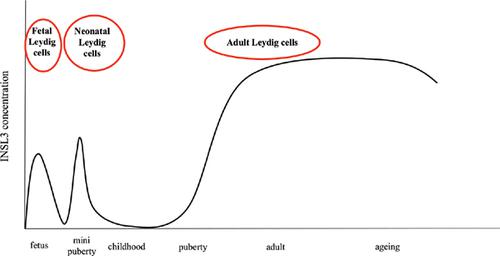Protein & Peptide Letters ( IF 1.0 ) Pub Date : 2020-11-30 , DOI: 10.2174/0929866527666200925105739 Paolo Facondo 1 , Andrea Delbarba 2 , Filippo Maffezzoni 2 , Carlo Cappelli 1 , Alberto Ferlin 1

|
This article reviews the role of INSL3 as biomarker of Leydig cell function and its systemic action in testis-bone-skeletal muscle crosstalk in adult men. Insulin-like factor 3 (INSL3) is a peptide hormone secreted constitutively in a differentiation-dependent mode by testicular Leydig cells. Besides the role for the testicular descent, this hormone has endocrine anabolic functions on the bone-skeletal muscle unit. INSL3 levels are low in many conditions of undifferentiated or altered Leydig cell status, however the potential clinical utility of INSL3 measurement is not yet well defined. INSL3 levels are modulated by the long-term cytotropic effect of the hypothalamicpituitary- gonadal axis, unlike testosterone that is acutely sensitive to the stimulus by luteinizing hormone (LH). INSL3 directly depends on the number and differentiation state of Leydig cells and therefore it represents the ideal marker of Leydig cell function. This hormone is more sensitive than testosterone to Leydig cell impairment, and the reduction of INSL3 in adult men can precociously detect an endocrine testicular dysfunction. Low INSL3 levels could cause or contribute to some symptoms and signs of male hypogonadism, above all sarcopenia and osteoporosis. The measurement provided suggested that the measurement of INSL3 levels should be considered in the clinical management of male hypogonadism and in the evaluation of testicular endocrine function. The monitoring of INSL3 levels could allow an early detection of Leydig cell damage, even when testosterone levels are still in the normal range.
中文翻译:

INSL3:睾丸间质细胞功能和睾丸-骨骼-骨骼肌网络的标志
本文综述了INSL3作为Leydig细胞功能生物标志物的作用及其在成年男性睾丸-骨骼-骨骼肌串扰中的全身作用。胰岛素样因子3(INSL3)是睾丸Leydig细胞以分化依赖性模式组成性分泌的肽激素。除了有助于睾丸下降外,这种激素还具有骨骼骨骼肌单位的内分泌合成代谢功能。在许多未分化或改变的Leydig细胞状态的情况下,INSL3的水平较低,但是,尚未很好地确定INSL3测量的潜在临床用途。INSL3水平受下丘脑-垂体-性腺轴的长期细胞增生作用调节,而睾丸激素对黄体生成激素(LH)的刺激非常敏感。INSL3直接取决于Leydig细胞的数量和分化状态,因此它代表Leydig细胞功能的理想标记。这种激素比睾丸激素对睾丸间质细胞损伤更敏感,成年男性中INSL3的减少可以早发现内分泌睾丸功能障碍。低的INSL3水平可能导致或促成男性性腺功能减退的某些症状和体征,尤其是肌肉减少症和骨质疏松症。所提供的测量结果表明,在男性性腺功能减退症的临床治疗和睾丸内分泌功能评估中应考虑INSL3水平的测量。即使睾丸激素水平仍在正常范围内,对INSL3水平的监测也可以早期发现Leydig细胞损伤。成年男性中INSL3的减少可以早发现内分泌睾丸功能障碍。低的INSL3水平可能会导致或促成男性性腺功能减退的某些症状和体征,尤其是肌肉减少症和骨质疏松症。所提供的测量结果表明,在男性性腺功能减退症的临床治疗和睾丸内分泌功能评估中应考虑INSL3水平的测量。即使睾丸激素水平仍在正常范围内,对INSL3水平的监测也可以早期发现Leydig细胞损伤。成年男性中INSL3的减少可以早发现内分泌睾丸功能障碍。低的INSL3水平可能会导致或促成男性性腺功能减退的某些症状和体征,尤其是肌肉减少症和骨质疏松症。提供的测量结果表明,在男性性腺功能减退症的临床治疗和睾丸内分泌功能评估中应考虑INSL3水平的测量。即使睾丸激素水平仍在正常范围内,对INSL3水平的监测也可以早期发现Leydig细胞损伤。所提供的测量结果表明,在男性性腺功能减退症的临床治疗和睾丸内分泌功能评估中应考虑INSL3水平的测量。即使睾丸激素水平仍在正常范围内,对INSL3水平的监测也可以早期发现Leydig细胞损伤。所提供的测量结果表明,在男性性腺功能减退症的临床治疗和睾丸内分泌功能评估中应考虑INSL3水平的测量。即使睾丸激素水平仍在正常范围内,对INSL3水平的监测也可以早期发现Leydig细胞损伤。











































 京公网安备 11010802027423号
京公网安备 11010802027423号